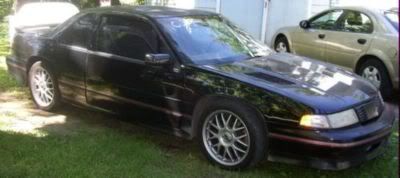Ok, that went rather well. I carried over most of my original tune to the BFUZ and it worked nicely. The goal of this was to fiddle around with the car some more, sure, but to also try and get rid of the realy annoying tip in stumble. I've tried to play with all the AE settings but just never got anything to work right. I could make a very quick shot as rich as I want, but never get it to last long enough to keep it from falling on its face. It would go from say 12:1 for a half second or less, to a spike of ~17:1 for around at second after usualy. Was almost like a tease. I know the VE tables being correct help, but even when they were nearly spot on, it would still do it. I also wanted to try and get some better mileage, and get another car running it for feed back.
Driving around now, most any tip in is met with a nice surge of throttle reponse! No falling on its face or anything. There is a deffinite switch over from single fire to double fire though. Its almost like it falls off a little, its soft, but just doens't seem to have the same umph after the switch to double fire. It takes a rather large throttle transition to hit it though, or the upper RPMs at WOT. I only did one WOT run through 3rd getting on the highway. Without a wide band, I'm not gonna push it much.
I have an idea why my original port didn't work. 2 tables, the double fire pulse width allow/dissalow scalars are way off. In the BFUZ port, they are 6.5 and 6.0, on mine they are 1.28 and .98. Other than that, I didn't see much that would cause a big issue. Watching my trims perodicaly while driving, they are around 5-8% rich for the most part, idle is nearly spot on, though the idle is still rather unsteady, with lots of stalling if I don't catch it. Not sure if its tuning yet, or an idle relearn er what. If people can check the logs and bins for insight, it would be much appreciated.
Overall I like whats been done, and I thank you Robbertissar for the work so far. Also thanks for the welcome, I've lurked here periodicaly for a while, some very good OBD1 info around.
Ok, XDLs aren't uploadable, so heres a couple:
This one is the first drive with the good bin...
Night drive 1
This is a shorter drive after playing with the follower real quick to see what would happen...
Night drive 2
As for the bins, 1.0 is the original port I tried using my tune. It might be useful to look at to figure out why it didn't run properly. 1.1 is what I was driving around on and works well.
I did have a 1.2, only changes were AE tables from my own tune. It was more curiosity on my part, to see what tip in would feel like on the new setup vs. old. It still didnt fall on its face, but didn't have the same umph feeling as the stock BFUZ settings, so I reverted back.
Driving around now, most any tip in is met with a nice surge of throttle reponse! No falling on its face or anything. There is a deffinite switch over from single fire to double fire though. Its almost like it falls off a little, its soft, but just doens't seem to have the same umph after the switch to double fire. It takes a rather large throttle transition to hit it though, or the upper RPMs at WOT. I only did one WOT run through 3rd getting on the highway. Without a wide band, I'm not gonna push it much.
I have an idea why my original port didn't work. 2 tables, the double fire pulse width allow/dissalow scalars are way off. In the BFUZ port, they are 6.5 and 6.0, on mine they are 1.28 and .98. Other than that, I didn't see much that would cause a big issue. Watching my trims perodicaly while driving, they are around 5-8% rich for the most part, idle is nearly spot on, though the idle is still rather unsteady, with lots of stalling if I don't catch it. Not sure if its tuning yet, or an idle relearn er what. If people can check the logs and bins for insight, it would be much appreciated.
Overall I like whats been done, and I thank you Robbertissar for the work so far. Also thanks for the welcome, I've lurked here periodicaly for a while, some very good OBD1 info around.
Ok, XDLs aren't uploadable, so heres a couple:
This one is the first drive with the good bin...
Night drive 1
This is a shorter drive after playing with the follower real quick to see what would happen...
Night drive 2
As for the bins, 1.0 is the original port I tried using my tune. It might be useful to look at to figure out why it didn't run properly. 1.1 is what I was driving around on and works well.
I did have a 1.2, only changes were AE tables from my own tune. It was more curiosity on my part, to see what tip in would feel like on the new setup vs. old. It still didnt fall on its face, but didn't have the same umph feeling as the stock BFUZ settings, so I reverted back.


 ), and an inconsistent chance of these happening.
), and an inconsistent chance of these happening.



Comment